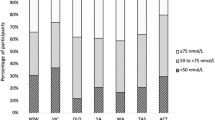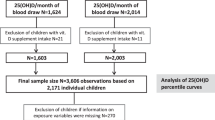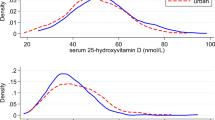Abstract
Background/objectives
Sufficient vitamin A levels are important for many functions—and both too little and too much may have detrimental health effects. The aim of the study was to describe the distribution of retinol levels in Norwegian adolescents, the relation between lifestyle factors and retinol levels, and the relation between retinol levels and bone mineral density (BMD).
Subjects/methods
Serum retinol was measured in 414 girls and 474 boys aged 15–19 years, participating in the Tromsø Study: Fit Futures. Questionnaires regarding health and lifestyle factors were filled in, and physical examinations, body composition, and bone mineral density measurements (DEXA) performed. Multiple regression analyses were used to discover associations between retinol and exposure variables.
Results
Retinol levels ranged from 0.26 to 6.46 μmol/L with a median (2.5–97.5 percentile) of 2.35 (1.01–4.67) μmol/L. There was no gender difference. In the multivariate models, fat mass, albumin level, physical activity, and lunch habits were positively associated with retinol levels in boys. In girls, fat mass and height were negatively associated with retinol levels, and lean mass, vitamin D, calcium, total cholesterol, and the use of contraceptives were positively associated with retinol levels (p < 0.05). The models explained 18.3% and 14.6% of the variation (R2) in girls and boys, respectively. Retinol levels were not independently associated with BMD.
Conclusion
Retinol levels in Norwegian adolescents are higher than reported elsewhere, and are to a low degree explained by lifestyle and physical measurements. No independent association with BMD was found.
This is a preview of subscription content, access via your institution
Access options
Subscribe to this journal
Receive 12 print issues and online access
$259.00 per year
only $21.58 per issue
Buy this article
- Purchase on Springer Link
- Instant access to full article PDF
Prices may be subject to local taxes which are calculated during checkout


Similar content being viewed by others
References
Blomhoff R, Blomhoff HK. Overview of retinoid metabolism and function. J Neurobiol. 2006;66:606–30.
Tanumihardjo SA. Vitamin A: biomarkers of nutrition for development. Am J Clin Nutr. 2011;94:658s–65s.
Nordic Council of Ministers 2014. Nordic Nutrition Recommendations 2012: integrating nutrition and physical activity. Nord. 2014;5:335–348.
Borovaya A, Dombrowski Y, Zwicker S, Olisova O, Ruzicka T, Wolf R, et al. Isotretinoin therapy changes the expression of antimicrobial peptides in acne vulgaris. Arch Dermatol Res. 2014;306:689–700.
Blomhoff R, Beckman-Sundh U, Brot C, Solvoll K, Steingrimsdóttir L, Hauger Carlsen M. Health risks related to high intake of preformed retinol (vitamin A) in the Nordic countries. Nordic Council of Ministers. TemaNord 2003:27-36.
TINE [internet]. Oslo. Tinemelk Lettmelk 0.7% fett. http://www.tine.no/merkevarer/tinemelk/produkter/tinemelk-lettmelk-0-7-fett
Sauvant P, Cansell M, Atgie C. Vitamin A and lipid metabolism: relationship between hepatic stellate cells (HSCs) and adipocytes. J Physiol Biochem. 2011;67:487–96.
Wongsiriroj N, Jiang H, Piantedosi R, Yang KJ, Kluwe J, Schwabe RF, et al. Genetic dissection of retinoid esterification and accumulation in the liver and adipose tissue. J Lipid Res. 2014;55:104–14.
Nasjonal brukerhåndbok i Medisinsk Biokjemi [internet]. Vitamin A, P [Updated: 2014.09.09 Cited: 2014.09.09]. http://brukerhandboken.no/index.php?action=showtopic&topic=4f69553a168ffb1aebfb&j=1
Holvik K, Ahmed LA, Forsmo S, Gjesdal CG, Grimnes G, Samuelsen SO, et al. No increase in risk of hip fracture at high serum retinol concentrations in community-dwelling older Norwegians: the Norwegian Epidemiologic Osteoporosis Studies. Am J Clin Nutr. 2015;5:1289–96.
Rothman KJ, Moore LL, Singer MR, Nguyen US, Mannino S, Milunsky A. Teratogenicity of high vitamin A intake. N Engl J Med. 1995;333:1369–1373.
Michaëlsson K, Lithell H, Vessby B, Melhus H. Serum retinol levels and the risk of fracture. N Eng J Med. 2003;348:287–294.
Opotowsky AR, Bilezikian JP. Serum vitamin A concentration and the risk of hip fracture among women 50 to 74 years old in the United States: a prospective analysis of the NHANES I follow-up study. Am J Med. 2004;117:169–174.
Melhus H, Michaëlsson K, Kindmark A, Bergström R, Holmberg L, Mallmin H, et al. Excessive dietary intake of vitamin A is associated with reduced bone mineral density and increased risk for hip fracture. Ann Intern Med. 1998;129:770–778.
Valtuena J, Breidenassel C, Folle J, González-Gross M. Retinol, β-carotene, α-tocopherol and vitamin D status in European adolescents; regional differences an variability: a review. Nutr Hosp. 2011;26:280–288.
World Health Organization–Health for the world’s adolescents [internet]. Recognizing adolescence [Cited: 2014]. http://apps.who.int/adolescent/second-decade/section2/page1/recognizing-adolescence.html
Cole TJ, Flegal KM, Nicholls D, Jackson AA. Body mass index cut offs to define thinness in children and adolescents: international survey. BMJ. 2007;335:194.
Cole TJ, Bellizzi MC, Flegal KM, Dietz WH. Establishing a standard definition for child overweight and obesity worldwide: international survey. BMJ. 2000;320:1240–1243.
Winther A, Dennison E, Ahmed LA, Furberg AS, Grimnes G, Jorde R, et al. The Tromsø Study: fit futures: a study of Norwegian adolescents' lifestyle and bone health. Arch Osteoporos. 2014;9:185.
Bratberg GH, Nilsen TI, Holmen TL, Vatten LJ. Early sexual maturation, central adiposity and subsequent overweight in late adolescence. A four-year follow-up of 1605 adolescent Norwegian boys and girls: the Young HUNT study. BMC Public Health. 2007;7:54.
Brooks-Gunn J, Warren MP, Rosso J, Gargiulo J. Validity of self-report measures of girls’ pubertal status. Child Dev. 1987;58:829–841.
Petersen AC, Crockett L, Richards M, Boxer A. A self-report measure of pubertal status: reliability, validity, and initial norms. J Youth Adolesc. 1988;17:117–133.
Graff-Iversen S, Anderssen SA, Holme IM, Jenum AK, Raastad T. Two short questionnaires on leisure-time physical activity compared with serum lipids, anthropometric measurements and aerobic power in a suburban population from Oslo, Norway. Eur J Epidemiol. 2008;23:167–174.
World Health Organization. Serum retinol concentrations for determining the prevalence of vitamin A deficiency in populations [Internet]. WHO/NMH/NHD/MNM/11.3. 2011: 1–5. http://www.who.int/vmnis/indicators/retinol/en/
World Health Organization and Food and Agriculture Organization of the United Nations 2004. Vitamin and mineral requirements in human nutrition. 2nd ed. China: Sun Fung; 2004; p. 341 pages.
Min KB, Min JY. Relation of serum vitamin A levels to all-cause and cause-specific mortality among older adults in the NHANES III population. Nutr Metab Cardiovasc Dis. 2014;24:1197–203.
Ansari EA, Sahni K, Etherington C, Morton A, Conway SP, Moya E, et al. Ocular signs and symptoms and vitamin A status in patients with cystic fibrosis treated with daily vitamin A supplements. Br J Ophthalmol. 1999;83:688–691.
Grimnes G, Almaas B, Eggen AE, Emaus N, Figenschau Y, Hopstock LA, et al. Effect of smoking on the serum levels of 25-hydroxyvitamin D depends on the assay employed. Eur J Endocrinol. 2010;163:339–48.
Cashman KD, Dowling KG, Skrabakova Z, Gonzalez-Gross M, Valtuena J, De Henauw S, et al. Vitamin D deficiency in Europe: pandemic? Am J Clin Nutr. 2016;103:1033–44.
Albuquerque M, Diniz A, Arruda I. Elevated serum retinol and low beta-carotene but not alpha-tocopherol concentrations are associated with dyslipidemia in Brazilian adolescents. J Nutr Sci Vitaminol. 2016;62:73–80.
Bjelakovic G, Nikolova D, Simonetti RG, Gluud C. Systematic review: primary and secondary prevention of gastrointestinal cancers with antioxidant supplements. Aliment Pharmacol Ther. 2008;28:689–703.
Jeong NH, Song ES, Lee JM, Lee KB, Kim MK, Cheon JE, et al. Plasma carotenoids, retinol and tocopherol levels and the risk of ovarian cancer. Acta Obstet Gynecol Scand. 2009;88:457–62.
Weiping L, Qingfeng C, Shikun M, Xiurong L, Hua Q, Xiaoshu B, et al. Elevated serum RBP4 is associated with insulin resistance in women with polycystic ovary syndrome. Endocrine. 2006;30:283–7.
Wickenheisser JK, Nelson-DeGrave VL, Hendricks KL, Legro RS, Strauss JF 3rd, McAllister JM. Retinoids and retinol differentially regulate steroid biosynthesis in ovarian theca cells isolated from normal cycling women and women with polycystic ovary syndrome. J Clin Endocrinol Metab. 2005;90:4858–65.
Jiang Y, Li C, Chen L, Wang F, Zhou X. Potential role of retinoids in ovarian physiology and pathogenesis of polycystic ovary syndrome. Clin Chim Acta. 2017;469:87–93.
Cruz JA, Moreiras-Varela O, van Staveren WA, Trichopoulou A, Roszkowski W.Intakes of vitamins and minerals. Eur J Clin Nutr. 1991;45:121–38.
Totland TH, Melnæs BK, Lundberg-Hallén N, Helland-Kigen KM, Lund-Blix NA, Myhre JB, et al. Norkost 3. En landsomfattende kostholdsundersøkelse blant menn og kvinner i Norge i alderen 18–70 år, 2010–11. Helsedirektoratet 2012
Youtick JJ, Jung CT, Bronaugh RL. In vitro and in vivo percutaneous absorption of retinol from cosmetic formulations: significance of the skin reservoir and prediction of systemic absorption. Toxicol Appl Pharmacol. 2008;231:117–21.
Herbeth B, Spyckerelle Y, Deschamps JP. Determinants of plasma retinol, beta-carotene, and alpha-tocopherol during adolescence. Am J Clin Nutr. 1991;54:884–9.
Gracia-Marco L, Valtuena J, Ortega FB, Perez-Lopez FR, Vicente-Rodriguez G, Breidenassel C, et al. Iron and vitamin status biomarkers and its association with physical fitness in adolescents: the HELENA study. J Appl Physiol. 2012;113:566–573.
Vahlquist A, Johnsson Kg, Nygren. Vitamin A transporting plasma proteins and female sex hormones. Am J Clin Nutr. 1979;32:1433–1438.
Tang G, Qin J, Dolnikowski GG, Russell RM. Short-term (intestinal) and long-term (postintestinal) conversion of beta-carotene to retinol in adults as assessed by a stable-isotope reference method. Am J Clin Nutr. 2003;78:259–66.
Oberg J, Jorde R, Almås B, Emaus N, Grimnes G. Vitamin D deficiency and lifestyle risk factors in a Norwegian adolescent population. Scand J Public Health. 2014;7:593–602.
Furr HC, Green MH, Haskell M, Mokhtar N, Nestel P, Newton S, et al. Stable isotope dilution techniques for assessing vitamin A status and bioefficacy of provitamin A carotenoids in humans. Public Health Nutr. 2005;8:596–607.
Tanumihardjo SA. Assessing vitamin A status: past, present and future. J Nutr. 2004;134:290S–3S.
Acknowledgements
The author is grateful to the study participants, the staff at the Centre for Clinical Research and Education and the Fit Futures administration.
Funding:
The present study was supported by the The Northern Norway Regional Health Authority and UiT—The Arctic University of Norway.
Author information
Authors and Affiliations
Corresponding author
Ethics declarations
Conflict of interest
The authors declare that they have no conflict of interest.
Rights and permissions
About this article
Cite this article
Teigmo, M.S.W., Gundersen, T.E., Emaus, N. et al. Distribution and determinants of retinol in Norwegian adolescents, and its relation to bone mineral density: the Tromsø Study: Fit Futures. Eur J Clin Nutr 72, 1373–1384 (2018). https://doi.org/10.1038/s41430-018-0193-z
Received:
Revised:
Accepted:
Published:
Issue Date:
DOI: https://doi.org/10.1038/s41430-018-0193-z



